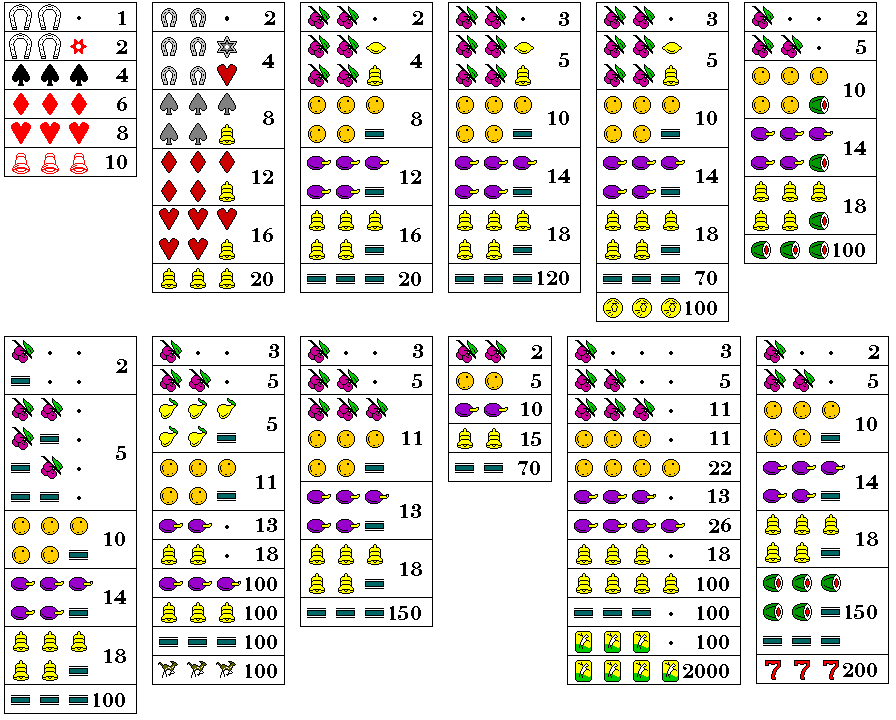
Repeating the earlier image of slot machine payouts through the years for ease of reference:

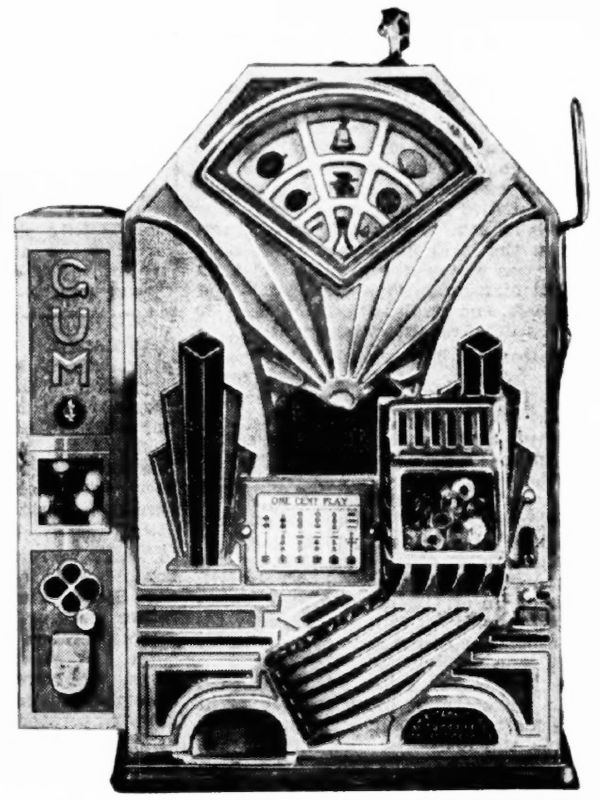
Although the more generous set of payouts shown in the second and third sections of the diagram above was introduced with machines that had twenty symbols on each reel, and thus 8,000 possible combinations, it was possible to use these payouts with a machine that, like Charles Fey's original Liberty Bell, had only ten symbols on each reel, and only 1,000 combinations. Thus, for example, the Jennings Little Duke from 1932, pictured at right, where the innermost wheel corresponded to the leftmost reel on a conventional slot machine, had this arrangement of symbols:
(*) Lemons 2 - 3 (%) Cherries 3 5 - (O) Oranges 2 2 2 (@) Plums 1 1 3 (A) Bells 1 1 1 (=) Bars 1 1 1
The proportion of 1,000 coins spent on the machine that is paid out in prizes on average can be calculated as follows:
Reel Combinations Value Amount
1 2 3 Paid
3 * 5 * 10 = 150 * 2 = 300
3 * 5 * 4 = 60 * 4 = 240
2 * 2 * 3 = 12 * 8 = 96
1 * 1 * 4 = 4 * 12 = 48
1 * 1 * 2 = 2 * 16 = 32
1 * 1 * 1 = 1 * 20 = 20
----
736
After the Jennings "Little Duke", in 1933 there was another slot machine using concentric disks, one version of the Pierce "Whirlwind". While Jennings made a conventional three-reel slot machine resembling the Little Duke which it called the Duchess, Pierce applied the Whirlwind name to both a machine with concentric disks and a conventional three-reel machine. These two machines, followed by the Jennings Duchess, are shown below:
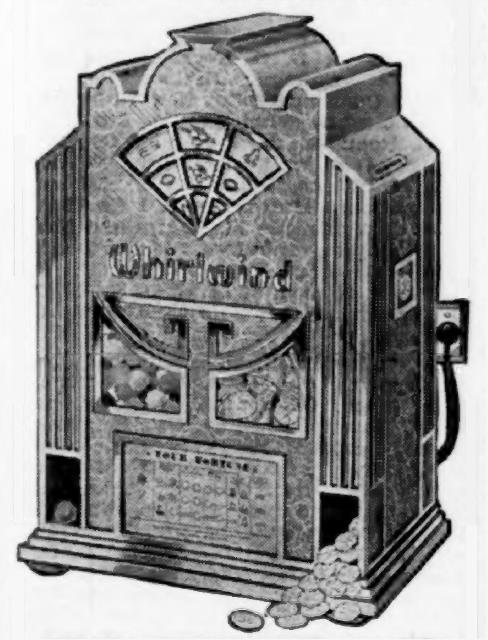


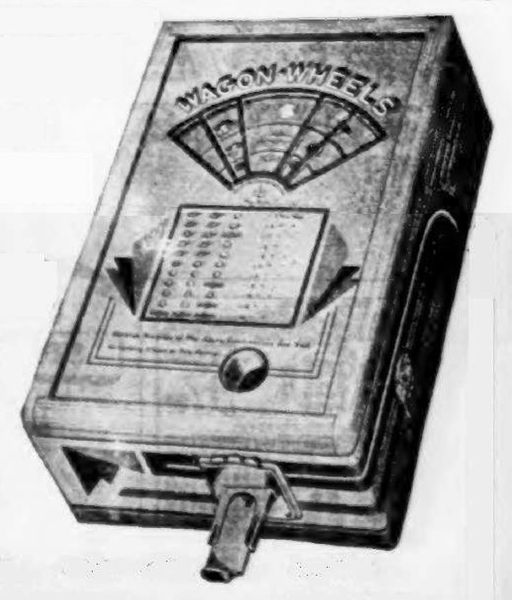
Also, in late 1935, the A. B. T. Manufacturing Company made a countertop machine of a similar design called "Wagon Wheels", shown at right. This was a trade stimulator rather than a slot machine, as it lacked an automatic payout feature. It also came in versions with other symbols, by the names Sportland and Prosit.
Of course, in addition to these real-world examples of slot machines which use concentric discs instead of reels, the spherical alien slot machines in the Canto Bight casino in the movie The Last Jedi were of that general type as well.
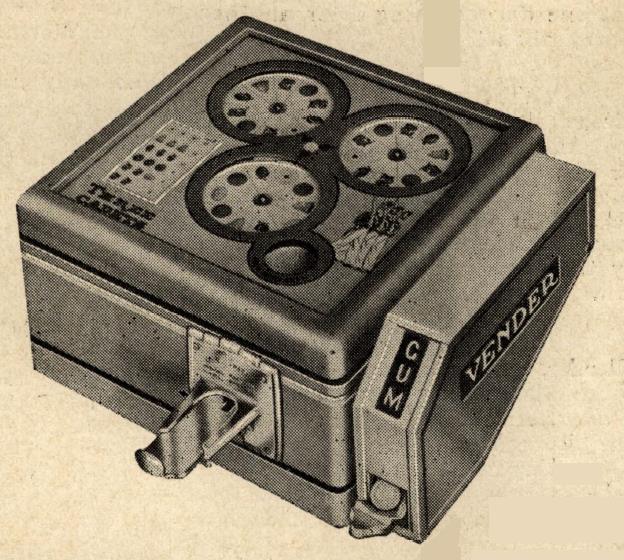
Another trade stimulator featuring an alternative to reels is the Three Cadets, by C. H. Fey Manufacturing, shown at right.
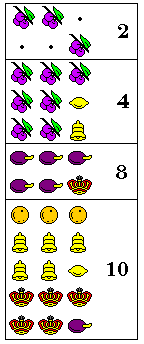
An ingenious design allowing the use of three disks of equal size is used by a European maker of slot machines, for the "Rotamint" machine. Of the three symbols in a row, the leftmost one is provided by a disk the center of which is to the left of the window, and the rightmost is provided by a disk the center of which is to the right of the window. So the symbols are printed on the left disk so that if you go "upwards" you move counter-clockwise, and on the right disk, moving along the symbols in the direction of their tops is clockwise.
A gap is left between those two disks, where the middle symbol can be displayed. The third disk that supplies that symbol has its center directly below the center of the window, and the symbols are printed on it with their tops radiating outwards, just as on the three disks of the Little Duke.
The diagram below will perhaps make the principle more obvious than an explanation in words:
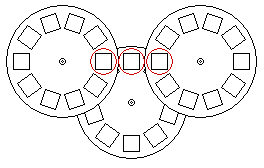
Most Rotamint machines had numbers on the wheels, sometimes with a limited mixture of other symbols, but at least one model, the 6 Fruit 6, used the Mills fruit symbols. Its payouts are shown to the right, and, as can be seen, they did differ somewhat in philosophy from those of American slot machines with those symbols.
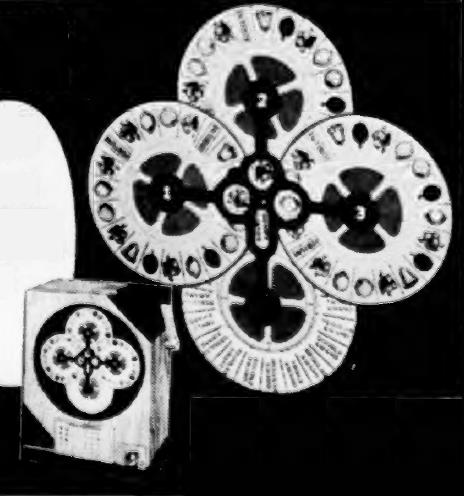
The Rotamint machine turns out to have been anticipated, I recently learned, by the "4 Leaf Clover" from the Pierce Tool and Manufacturing Company in 1935. Shown at left is a detail from an advertisement for this machine, showing a close-up of the reels behind a small picture of the machine itself. However, it did not fully anticipate all the features of the Rotamint.
It had four disks, three with fruit symbols, and one which indicated if a regular pay or a double or triple pay would be given in the event of a win. (It was a trade stimulator, so, without automatic payout, this did not complicate the mechanism.)
The three wheels with fruit symbols were identical, instead of having the symbols oriented on each wheel so that the symbols in the payout area would be upright, and the payout area was in the shape of a diamond, so the opportunity of having three symbols in a line was not used.
Although the payout structure was like that of an older slot machine, with two cherries and cherry-cherry-lemon and cherry-cherry-bell being winning combinations, as it used three identical wheels, the cherry was possible in the third position, and the lemon in any position.
Each wheel had:
Lemon 4 Cherry 6 Orange 3 Plum 3 Bell 2 Bar 2
Unlike the Rotamint, there were twenty symbols on each wheel rather than just ten.
Of course, there are many other possible ways to design an unconventional slot machine. One that I recently learned about was used by the British company Brecknell, Dolman, and Rodgers, or BDR: the three symbols displayed vertically, and were read from the top down. They were on reels, rather than discs, and the axis of the reels was directly vertical, but the reels were shaped like part of a cone with the upper reels smaller, thus allowing for a somewhat more compact machine.
Also, some European slot machines, while using conventional reels and conventional fruit symbols, had payout schedules that were very different from those of most slot machines. For example, at one time in Britain, slot machines were legal, but under some severe restrictions: to make them a relatively harmless form of gambling, the maximum payout was limited to 12 coins.
That led to one machine, the Kraft Sterling, based on a Beromat mechanism from the German firm of Gunther Wulff, as well as a few other similar ones, compensating by offering a large number of winning combinations:
Bell or Bell or
Plum or Orange or (Any) 2
Cherries Cherries
Bell or Orange Bell or
Plum Plum or 4
Orange
Plum Bell Bell or
Plum or 8
Orange
Bell Bell Bell or
Plum or 12
Orange
which was very much unlike the payout schedule of a conventional slot machine. The reels had five different symbols, one of them being a Pear, which was not part of any winning combination, the other four being Cherries, Orange, Plum, and Bell. It's possible the unusual payout schedule is partly due to a simplified payout mechanism, something like the case of the Mills QT.
A BDR slot machine - of the type where the three reels are arranged in a vertical truncated cone - despite having higher payouts and a conventional jackpot, also had a payout arrangement with a somewhat similar philosophy:
Plum (Any) (Any) 3
Cherries or Orange (Any) 3
Union Jack
Cherries or Cherries or Lemon 6
Union Jack Union Jack
Cherries or Cherries or Plum 9
Union Jack Union Jack
Cherries Cherries or Union Jack 12
Union Jack
Union Jack Cherries Union Jack 15
Union Jack Union Jack Union Jack Jackpot + 18
On the first reel, the machine had banannas, oranges, strawberries, and lemons, not only the symbols which could participate in a payout, and no doubt that was true of the other reels as well.

Its payout schedule, shown at right, was like that of a conventional slot machine, but with payouts from the first two wheels as well. Despite that, with the very low payouts allowed, it's hard to see how it could have avoided a very low payout percentage.
The sevens were overprinted on other symbols; but, surprisingly, the machine also had a strawberry symbol present on the third reel.
At one point, I thought that perhaps it replaced a lemon, with the machine using elements of the mechanism of a Mills 21 Bell slot machine repurposed; the use of a non-paying symbol to limit the payout percentage seems hardly necessary under these circumstances.
However, the story is more complicated than that, as the machine did also have lemons on the third reel. While the 7 was overprinted on a bar on the third reel, as with the 21 Bell, it was overprinted on a melon on the first reel, and on a bell on the second reel, so apparently it did have a reel strip design of its own.
Instead of taking a penny, another machine we will consider, the Bell-Fruit Three Penny Supreme took a three-penny coin (a coin the size of a nickel, but much thicker, made of nickel brass; like a nickel (well, at least an older, Canadian one), it was polygonal instead or round. Three sevens paid out a "Gold Award Token", so apparently merchandise prizes in excess of twelve pence were permitted.
Instead of trying to describe the size of a three-penny bit, I decided that it would make more sense to include a photograph, to allow people to see how large one is.
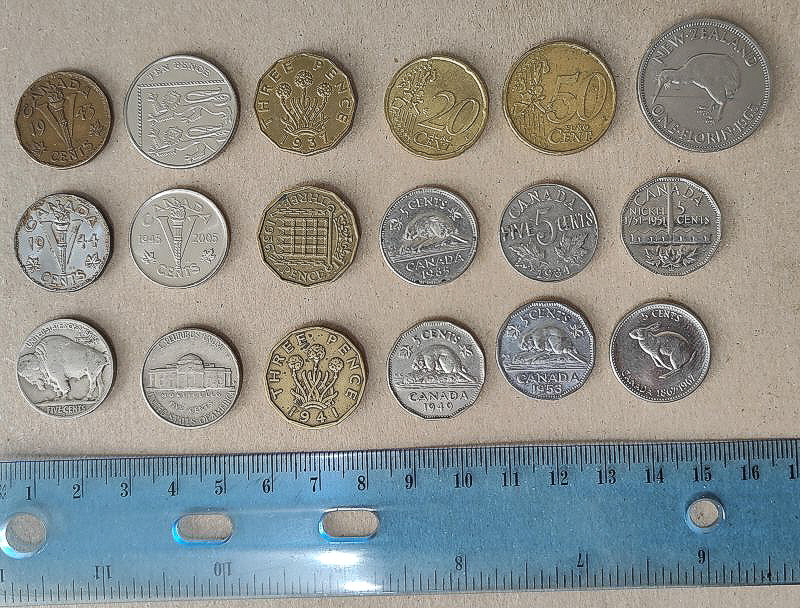
The top row contains a wartime Canadian nickel made from the alloy called "Tombac", and then a modern decimal ten pence coin from the United Kingdom, followed by a three-pence British coin, a 20 Euro cent coin and a 50 Euro cent coin, and a pre-decimal two-shilling coin, or Florin, from New Zealand.
The second coin contains a wartime Canadian nickel made from chrome-plated steel, followed by a modern commemorative coin saluting this wartime nickel and the one above it. Then there's another threepence, followed by an ordinary modern Canadian nickel, an older Canadian nickel, and a Canadian nickel with a special design celebrating Canada's nickel industry.
The third row begins with a Buffalo nickel, and then a Jefferson nickel, from the United States, another threepence, and then a postwar Canadian nickel with the standard beaver design, but which is twelve-sided, as Candian nickels all were for several years, and as several other examples we've seen were, then another nickel with the standard beaver design, but also, like the wartime nickel, made of chrome-plated steel, and finally a nickel from the special set commemorating Canada's Centennial in 1967.
A ruler is also present in the photograph, to allow people from any country to get an idea of the size of the British threepence coin.